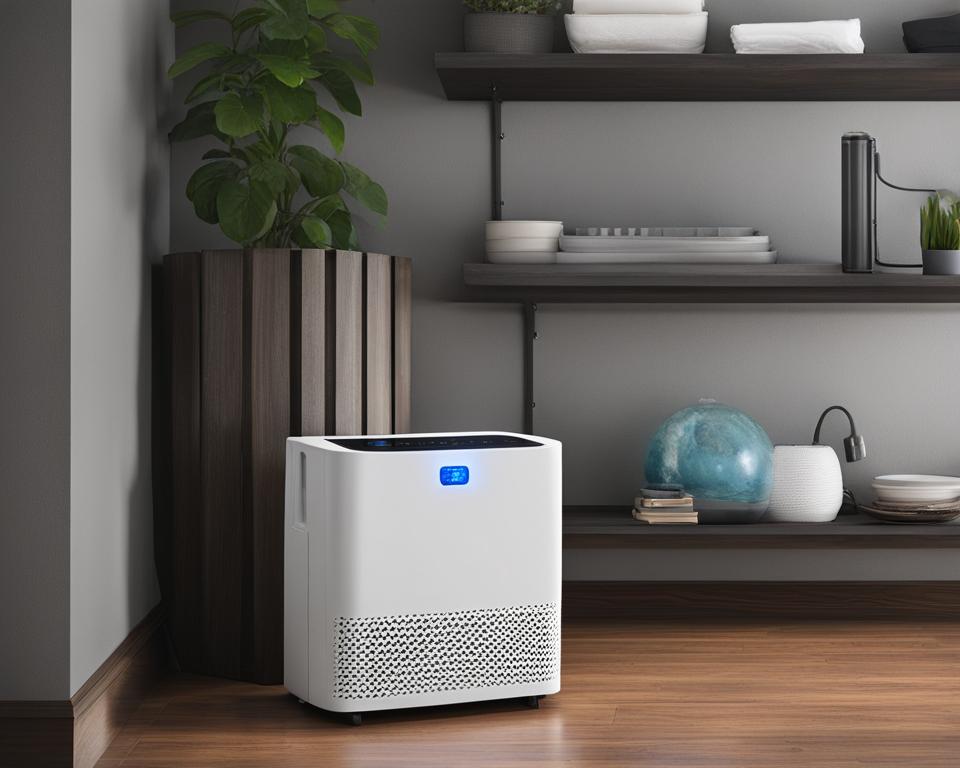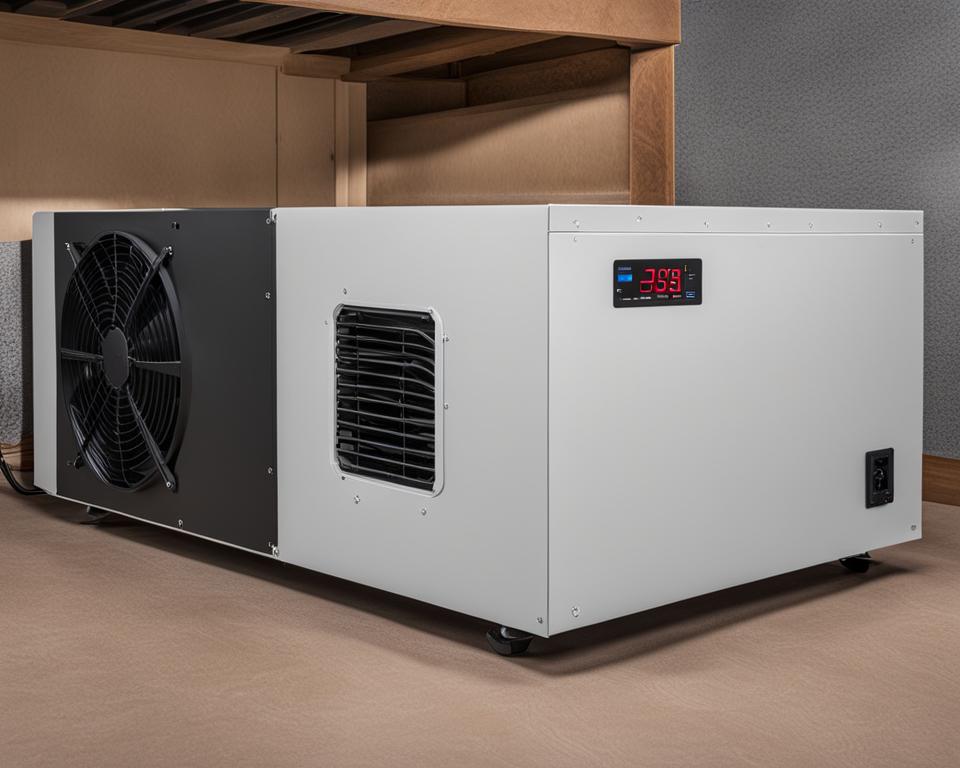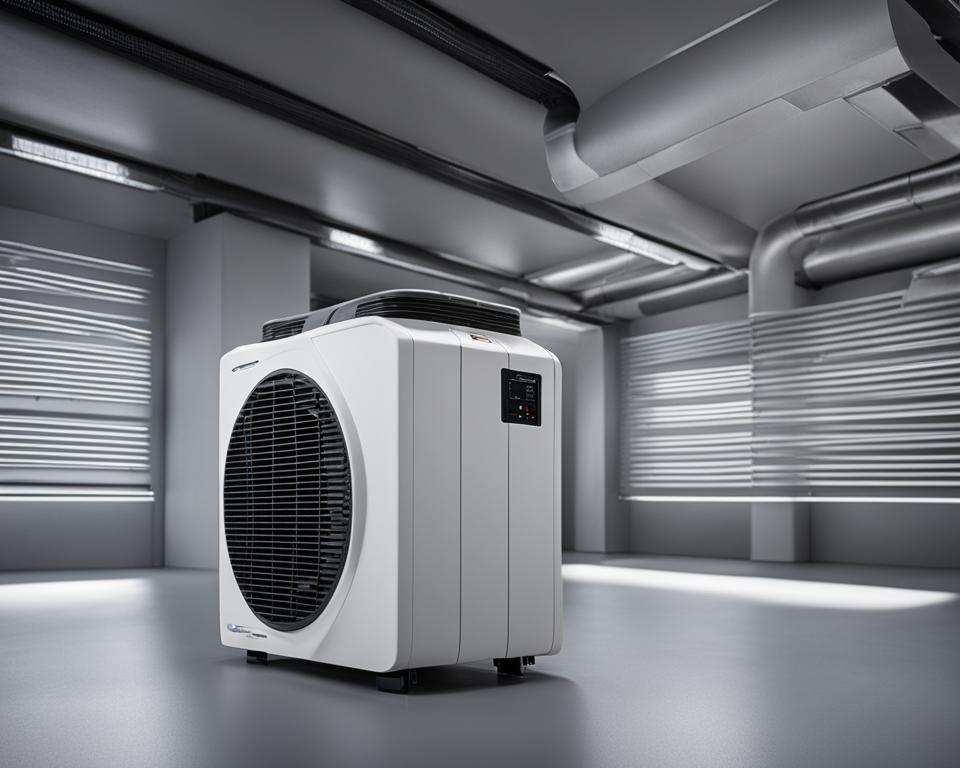Excessive moisture in crawl spaces can lead to issues like mold growth, wood decay, and musty odors. To prevent these problems, it’s important to invest in a high-capacity crawl space dehumidifier. These dehumidifiers are designed specifically for large crawl spaces and offer features like moisture control, humidity reduction, and mold and mildew prevention. By using a crawl space dehumidifier, you can maintain a dry and healthy crawl space, improve indoor air quality, and protect the structural integrity of your home.
- A high-capacity crawl space dehumidifier is essential for preventing issues like mold growth and wood decay.
- These dehumidifiers offer features like moisture control, humidity reduction, and mold and mildew prevention.
- Using a crawl space dehumidifier helps maintain a dry and healthy crawl space and improves indoor air quality.
- Investing in a crawl space dehumidifier protects the structural integrity of your home.
- Regular maintenance, such as sealing off crawl space vents and applying a moisture barrier, is important for overall crawl space health.
The Advantages of Using a Crawl Space Dehumidifier
A crawl space dehumidifier offers several benefits for homeowners. Firstly, it enhances the air quality in your home by managing humidity and reducing musty odors. Excessive moisture in the crawl space can lead to the growth of mold and mildew, which can negatively impact indoor air quality and pose health risks. By controlling humidity levels with a dehumidifier, you can create a healthier and more comfortable living environment.
Secondly, a crawl space dehumidifier helps maintain the structural integrity of your home. Excess moisture can lead to issues like wood decay and corrosion, which can weaken the foundation and framework of your house. By reducing moisture levels in the crawl space, a dehumidifier helps prevent these problems and ensures the long-term stability and durability of your home.
Thirdly, using a crawl space dehumidifier can result in energy savings. Excess humidity in the crawl space can make your HVAC system work harder to maintain a comfortable temperature, leading to higher energy consumption and increased utility bills. By managing humidity levels with a dehumidifier, you can reduce the workload on your HVAC system and potentially lower your energy costs.
Lastly, a crawl space dehumidifier creates an environment that is less appealing to pests like termites. Moisture attracts pests and provides an ideal breeding ground for them. By maintaining a dry crawl space with a dehumidifier, you can help prevent infestations and protect your home from potential damage caused by pests.
Advantages of Using a Crawl Space Dehumidifier:
- Enhanced air quality by managing humidity and reducing musty odors
- Maintained structural integrity by preventing wood decay and corrosion
- Potential energy savings by reducing the workload on your HVAC system
- Pest prevention by creating a less appealing environment for pests like termites
Choosing the Right Size Dehumidifier for Your Crawl Space
When it comes to selecting a crawl space dehumidifier, it’s crucial to choose the right size for your specific needs. Several factors should be taken into account to ensure optimal performance and efficiency.
Determining Crawl Space Area
The first step in choosing the right dehumidifier size is to determine the area of your crawl space. Measure the length and width of the space and multiply the two measurements to get the total square footage. This will give you an idea of the size range you should be looking for.
Considering Humidity Level
The humidity level in your crawl space is another important factor to consider. Use a hygrometer to measure the relative humidity (RH) in the area. If your crawl space consistently has a high humidity level above 60%, you will need a dehumidifier with a higher capacity to effectively remove moisture from the air.
Evaluating Crawl Space Temperature
The temperature in your crawl space can also affect the performance of the dehumidifier. Higher temperatures increase humidity levels, making it more challenging for the dehumidifier to extract moisture. If your crawl space tends to be warmer, you may need a dehumidifier with a higher capacity to handle the increased moisture load.
Assessing Crawl Space Status
The status of your crawl space, whether it is sealed or ventilated, will also impact your dehumidifier choice. Sealed crawl spaces require dehumidifiers specifically designed for enclosed spaces, while ventilated crawl spaces may benefit from units that can handle larger volumes of air.

| Crawl Space Area (Square Footage) | Recommended Dehumidifier Capacity (Pints per Day) |
|---|---|
| Less than 1,000 | 30 – 40 |
| 1,000 – 2,000 | 40 – 50 |
| 2,000 – 3,000 | 50 – 60 |
| 3,000 – 4,000 | 60 – 70 |
Keep in mind that these are general guidelines, and it’s always recommended to consult the manufacturer’s specifications for the specific dehumidifier model you are considering. Additionally, it’s advisable to seek professional advice to ensure you choose the right size dehumidifier for your crawl space.
Top 10 Dehumidifiers for Large Crawl Spaces
When it comes to choosing the right dehumidifier for your large crawl space, there are several top-rated options available. These dehumidifiers are specifically designed to handle the unique challenges of large crawl spaces and provide effective moisture control. Here are the top 10 dehumidifiers that you should consider:
| Dehumidifier | Description |
|---|---|
| ALORAIR-120 PPD CrawlSpace Dehumidifier | This energy-efficient dehumidifier can remove up to 120 pints of water per day, making it ideal for large crawl spaces. |
| APRILAIRE E080 Pro 80 Pint Dehumidifier | Featuring a digital wall mount for convenient operation, this dehumidifier offers powerful moisture removal. |
| Moiswell Commercial Dehumidifier | With a high moisture removal rate of up to 145 pints per day, this dehumidifier is perfect for large crawl spaces with excessive moisture. |
| ALORAIR Commercial Dehumidifier with Pump | This dehumidifier comes with a built-in pump for continuous drainage, eliminating the need for manual emptying of the water tank. |
| Homelabs Dehumidifier | Designed for large spaces, this dehumidifier effectively removes excess moisture, helping to maintain optimal humidity levels. |
| Moiswell Dehumidifier | Equipped with advanced features, this dehumidifier offers efficient moisture control and is suitable for large crawl spaces. |
| ALORAIR Commercial Dehumidifier 120 PPD with Drain Hose | Featuring a built-in drain hose, this dehumidifier ensures hassle-free continuous drainage for large crawl spaces. |
| Waykar Crawl Space Dehumidifier with Wired Remote Control | This dehumidifier offers convenient remote control operation and effectively removes excess moisture from large crawl spaces. |
| ALORAIR 70 PPD – Energy Star Crawlspace Dehumidifiers | With its Energy Star certification, this dehumidifier provides efficient moisture control for large crawl spaces while minimizing energy consumption. |
| SAHAUHY Crawl Space Dehumidifier with Washable Filter | Featuring a washable filter, this dehumidifier offers easy maintenance and reliable moisture control for large crawl spaces. |
These top-rated dehumidifiers for large crawl spaces are designed to effectively control moisture, prevent mold and mildew growth, and improve indoor air quality. Consider your specific needs and crawl space size when selecting the right dehumidifier for your home. With the help of these high-quality dehumidifiers, you can maintain a dry and healthy crawl space, protecting your home and ensuring a comfortable living environment.
Factors to Consider When Choosing a Crawl Space Dehumidifier
When selecting a crawl space dehumidifier, it’s important to consider various factors to ensure you make the right choice for your specific needs. In addition to the size and capacity of the dehumidifier, there are three key factors to consider: the drainage system, noise level, and energy consumption.
Drainage System
The drainage system of the dehumidifier plays a crucial role in its functionality and convenience. Some dehumidifiers require manual draining, which means you’ll have to empty the water tank regularly. This can be time-consuming and inconvenient. On the other hand, dehumidifiers with built-in pumps allow for continuous draining. These models automatically pump out the collected water, eliminating the need for manual intervention.
Noise Level
The noise level of the dehumidifier is an important consideration, especially if your crawl space is located near living areas or bedrooms. High decibel levels can be disruptive and affect occupants’ well-being. Look for dehumidifiers that are specifically designed for quiet operation. These models typically have noise reduction features, such as insulated motors and vibration-absorbing components, to minimize noise levels.
Energy Consumption
Energy consumption is another crucial factor to consider when choosing a crawl space dehumidifier. Opting for an energy-efficient model can result in cost savings and reduce your environmental impact. Look for dehumidifiers with Energy Star ratings, as these models meet strict energy efficiency guidelines set by the Environmental Protection Agency (EPA). Energy-efficient dehumidifiers are designed to operate at optimal levels while minimizing energy consumption.

By taking into account these factors – drainage system, noise level, and energy consumption – you can make an informed decision when choosing a crawl space dehumidifier. Consider your specific needs and preferences to ensure that the dehumidifier you select effectively addresses the moisture control requirements of your crawl space, operates quietly, and minimizes energy consumption.
Conclusion: Maintaining a Healthy Crawl Space
A crawl space dehumidifier is an essential tool in maintaining a healthy crawl space. By controlling moisture and preventing issues like mold growth and wood decay, a dehumidifier helps protect your home’s structural integrity and improve indoor air quality.
In addition to using a dehumidifier, regular crawl space maintenance is important. This includes sealing off crawl space vents, updating entry doors, installing drainage systems, applying insulation panels, and encapsulating the crawl space with a moisture barrier.
Professional services can provide expert guidance and ensure that all aspects of crawl space maintenance are properly addressed. They have the knowledge and experience to assess your crawl space and recommend the best solutions for moisture prevention and overall crawl space health.
By taking these steps, you can create a dry and healthy crawl space that contributes to the overall well-being of your home. Regular maintenance and the use of professional services will help you keep your crawl space in optimal condition, protecting your investment and ensuring a comfortable living environment for you and your family.
FAQ
Why do I need a crawl space dehumidifier?
Excessive moisture in crawl spaces can lead to issues like mold growth, wood decay, and musty odors. A crawl space dehumidifier helps prevent these problems by controlling moisture, reducing humidity, and preventing mold and mildew.
What are the benefits of using a crawl space dehumidifier?
Using a crawl space dehumidifier enhances indoor air quality, maintains the structural integrity of your home, reduces energy consumption, and helps prevent pest infestations.
How do I choose the right size dehumidifier for my crawl space?
Factors to consider when choosing the right size dehumidifier include the size of your crawl space, the humidity level, the temperature, and the status of your crawl space (sealed or ventilated).
What are some top-rated dehumidifiers for large crawl spaces?
Some top-rated dehumidifiers for large crawl spaces include the ALORAIR-120 PPD CrawlSpace Dehumidifier, APRILAIRE E080 Pro 80 Pint Dehumidifier, Moiswell Commercial Dehumidifier, ALORAIR Commercial Dehumidifier with Pump, Homelabs Dehumidifier, Moiswell Dehumidifier, ALORAIR Commercial Dehumidifier 120 PPD with Drain Hose, Waykar Crawl Space Dehumidifier with Wired Remote Control, ALORAIR 70 PPD – Energy Star Crawlspace Dehumidifiers, and SAHAUHY Crawl Space Dehumidifier with Washable Filter.
What factors should I consider when choosing a crawl space dehumidifier?
Important factors to consider include the drainage system (manual draining or built-in pump), noise level, and energy consumption of the dehumidifier.
How can I maintain a healthy crawl space?
Along with using a crawl space dehumidifier, crawl space maintenance involves sealing off crawl space vents, updating entry doors, installing drainage systems, applying insulation panels, and encapsulating the crawl space with a moisture barrier. Professional services can provide expert guidance and ensure comprehensive maintenance.

Leave a Reply